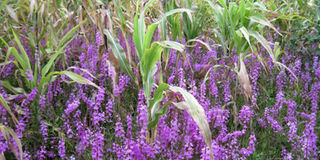Prime
Combat striga with push-pull technology

A maize garden infested with striga weed. Striga severely reduces crop yield. File photo
What you need to know:
Striga, also known as ‘‘witch weed’’, is a nightmare to several farmers mainly those growing cereals. It affects maize, millet, sorghum, rice, napier grass and sugarcane, writes Lominda Afedraru.
If you manage to visit farmers growing cereal crops in most parts of East Africa including Uganda, you will notice striga weed infestation is a huge challenge.
Striga also known as witch weed, is a coerce plant parasitic weed which infests roots of the host plant especially cereals belonging to the grass family.
It survives by siphoning water and nutrients required for its growth from host plants such as maize, rice, millet and sorghum among others thereby causing stunting and wilting of the host plants.
This has affected production rates of crops such as maize, sorghum, millet and rice mainly in the eastern part of Uganda and western part of Kenya.
Dr Michael Otim, the head of cereals at National Crops Resources Research Institute (NaCRRI), Namulonge, and Dr Charles Lwanga explain how farmers can manage and control this weed.
Intercropping
A scientific study has shown that an inter-cropping method used by farmers to control striga has the capability of increasing cereal yields.
The study, released by the Nairobi-based International Centre of Insect Physiology and Ecology’s (ICIPE), shows how effective the system, dubbed the climate smart push-pull technology, is.
It involves inter-cropping cereals with a pest repelling plant, such as desmodium, which drives away stem borers.
The desmodium plant repels stem borers from the target food crop while Napier grass, planted around the border of this inter-crop, pulls and traps the pests.
As a result, the food crop is protected from the pests, hence the name climate smart push-pull technology.
The study, done between 2013 and 2014, showed that the method effectively controls both stem borers and the striga weed.
Dr Lwanga with a team of scientists both in Uganda and Kenya have been evaluating striga infestation in farmer fields since 2013 and devised ways of how to curb the same.
“What exactly happens is that the weed attaches its roots to host plants and withdraws water and nutrients from the host plant causing stunting and wilting. When it grows, it produces seed which will germinate depending on the soil fertility,” says Dr Lwanga.
Resistant varieties
Dr Lwanga explains that apart from farmers adopting the usual traditional methods, scientists advise farmers to use herbicide resistant maize variety namely Longe7H IR (Imazapyr resistant) which is bred by NASECO seed company in Uganda jointly with the scientific team at NaCRRI. Many farmers are already growing this variety both in Kenya and Uganda.
These herbicide resistant varieties are treated with genes which provide resistance to the maize which after growing will cause the striga weed to dry off.
His team also bred hybrid varieties which were released in 2017 namely Naro maize 58 IR, Naro Miaze59 IR and Naro Maize60 IR with parent seed obtained from CYMMT Kenya.
Traditional control methods
Dr Lwanga and his team have sensitised farmers to restrict seed production and movement of cereal crops grown in striga affected areas. Farmers are encouraged to conduct early weeding of striga plants growing in cereal crop fields.
When it is too much in the field, farmers are encouraged to grow crotalaria plant as a trap, intercropping with none cereal crops, fallowing of the land and crop rotation are other measures to apply.
Push-pull method
The other measures farmers have been sensitised to embrace is the climate-smart push-pull technology where the host crop is intercropped with desmodium plant also known as tick clover, to stress striga germination.
These are planted in alternate rows at the same time napier grass is planted on the sides of the field to attract maize stem borer which is also ravaging maize growth in farms across East Africa.
The push-pull method will enable farmers to increase yields by 2.5 times, and in addition, integrate dairy farming into their production systems.
“We found that in the fields of farmers using the climate-smart push-pull, only about five per cent of the maize crop was destroyed by striga. In contrast, farmers not using the technology lost an approximate 40 per cent of their maize crop,” said Dr Lwanga.




